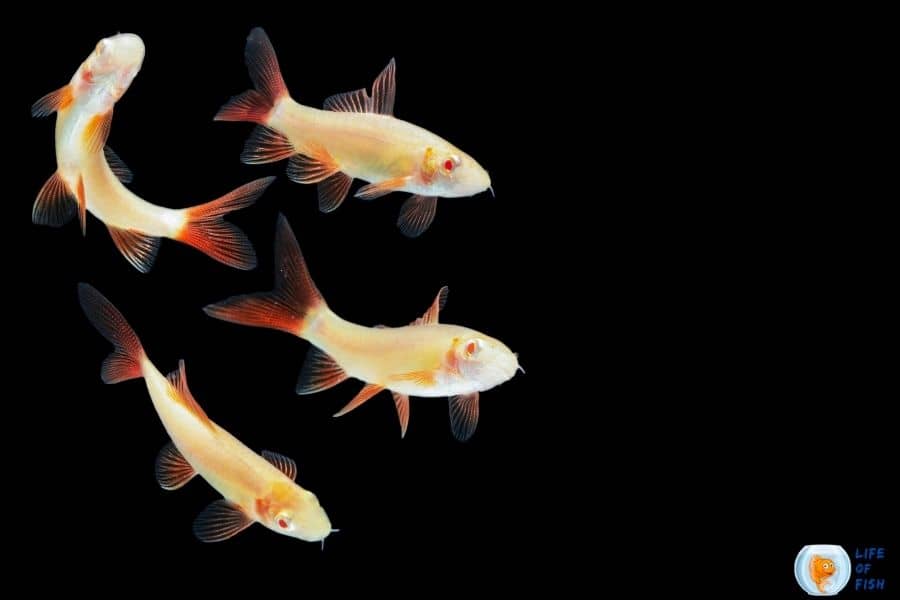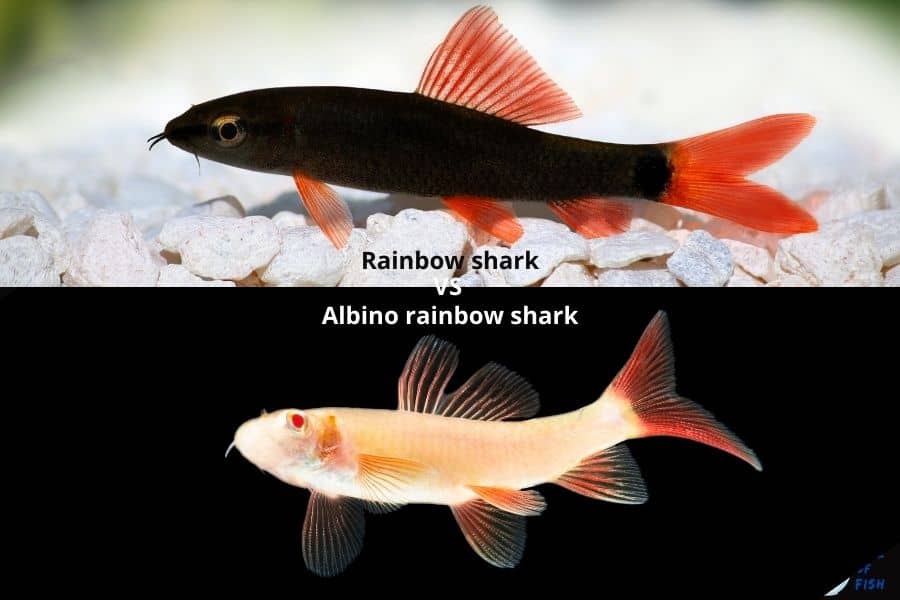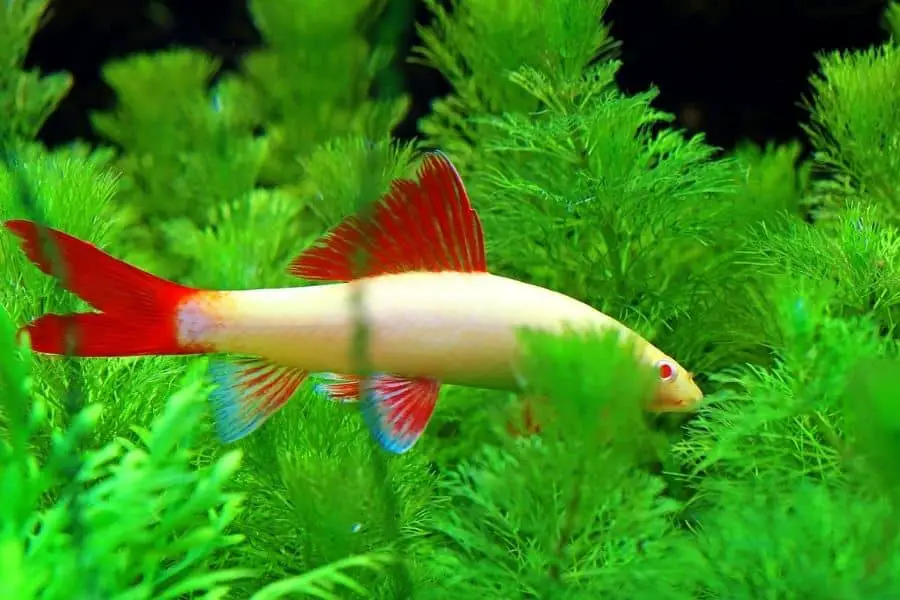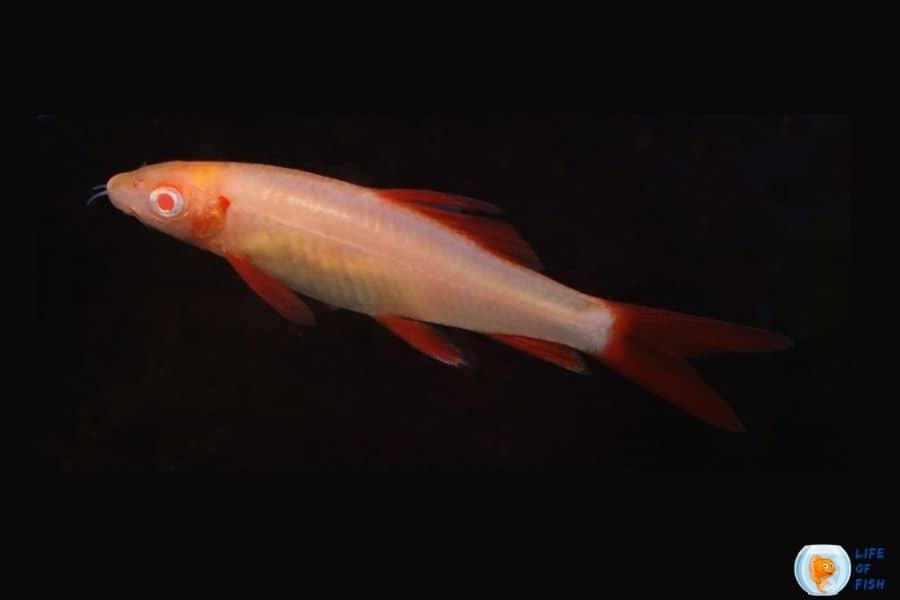If you are a shark lover, you won’t be disappointed with rainbow sharks as they closely resemble sharks. The albino rainbow shark is much more unique with its albino color and red fins. If your aquarium has a light color theme, the albino rainbow shark is the perfect choice for you.
If you control the water conditions in the aquarium well, these fish are not difficult to care for.
These fish require pristine water with no temperature fluctuations, which can be challenging for a beginner to accomplish. So, we prefer if you have intermediate-level knowledge to avoid complications.
Let’s find out what’s more these fish need to thrive in your aquarium.

What is the Albino rainbow shark?
Jump To
- 1 What is the Albino rainbow shark?
- 2 How big do Albino rainbow sharks get?
- 3 Is Albino rainbow shark aggressive?
- 4 Albino rainbow shark behavior
- 5 How long do Albino rainbow sharks live?
- 6 One look care guide
- 7 Albino rainbow shark care
- 8 Albino rainbow shark breeding
- 9 Special tips
- 10 How to feed Albino rainbow shark?
- 11 What fish can live with the Albino rainbow shark?
- 12 Related questions
- 13 Conclusion
They are the albino variety of the rainbow shark (Epalzeorhynchos frenatum) and are entirely different in appearance.
Although these fish look just like sharks, they do not belong to the Chondrichthyes lineage, which true sharks belong to.
Rainbow shark belongs to the actinopterygiian linage (ray-finned fish) and is a member of the Cyprinidae family, which makes them closely related to goldfish and carps.
Albino rainbow sharks are native to Indochina, where they are found in the basins of Mekong, Xe Bangfai, Chao Phraya, and Maeklong rivers.
Albino variety of rainbow sharks is also found in Thailand, where it is known as pla nue (ปลาเนื้อ), which means white meat fish.
In Thailand, these freshwater fish are found in the Oxbow lakes in Kanchanaburi province and are considered extinct in the Mekong river. Their status among other waters in Thailand is unknown.
Rainbow sharks are very active fish; they are excellent swimmers and constantly cruise around the aquarium, eating food or trying to escape.
How big do Albino rainbow sharks get?
Full-grown fish are about 6 inches (15 cm) in length, although they grow slightly bigger with age.
Is Albino rainbow shark aggressive?
Juvenile fish are not aggressive and do well with other tank mates.
But, as they grow bigger, they become aggressive and territorial. So, yes, Albino rainbow sharks are aggressive, therefore, do not fit in community tanks.
Albino rainbow shark behavior
Juvenile fish are generally timid. So, they will spend their time hiding most of the time.
They do not tend to fight with other fish, so there will be no problem raising juvenile albino rainbow sharks in your aquarium.
As these creatures grow up, they become highly territorial; hence they become aggressive. These fish are bottom-dwelling fish that try to dominate in their territory, which means the bottom of the tank.
So, any other fish that spend their time in the bottom of the tank will have a hard time with these fish. This includes their own kind if the tank is not large enough.
These fish are known to bite, butt, and chase other fish near them, although the other fish are peaceful. This is because they try to dominate and establish their territory on the bottom.
Although these fish try to attack other bottom-dwelling fish, they do well with other active species that do not mind swimming in the upper level.
Other than this aggressive behavior, these fish are beneficial for any aquarium because they clean the aquarium by eating off any leftover food, algae, or debris.

How long do Albino rainbow sharks live?
Albino sharks have a pretty good life expectancy of 5 years and longer if you take good care of them.
One look care guide
| Scientific name | Epalzeorhynchos frenatum |
| Common name | Albino rainbow shark |
| Care level | Moderate |
| Native to | Southeast Asia |
| Type | Freshwater bottom-dwelling fish |
| Color | Albino |
| Tank size | 55 gallons |
| Preferred temperature | 75°F to 81°F |
| Other water parameters (ammonia, etc.) | pH: 6.5 to 7.5 Hardness: 5 to 11 DH Ammonia: 0ppm Nitrite: 0ppm Nitrate: 20ppm |
| Preferred salinity | No salinity |
| Size | 6 inches (15cm) |
| Life Span | Up to 8 years |
| Temperament | Aggressive |
| Recommended tank mates | Gouramis Danios Loaches Barbs Plecos Rasboras Rainbowfish |
| Preferred food | Omnivores Fish pellets Flakes Algae wafers Vegetables Frozen bloodworms Brine shrimp |
| Feeding frequency | Two times per day |
| Breeding | Difficult in home aquaria, egg-laying fish |
Albino rainbow shark care
Caring for them is pretty straightforward if you provide stable water conditions in your tank. They do not demand any special tank setup.
They are not subject to any specific disease, so you will have no problem keeping them in your aquarium. But, like any other fish, they are prone to skin flukes and parasites.
Albino rainbow shark size
An albino rainbow shark size is about 6 inches (15 cm) in length, but some larger specimens can grow up to 7 inches (18 cm).
Albino rainbow shark tank size
These fish are active swimmers, so you should provide your fish with at least 55 gallons (209 L) tank size. If you plan to keep more bottom-dwelling fish, you should opt for a more spacious tank.
How many Albino rainbow sharks should be kept together?
In the wild, they tend to live in solitary. So, we recommend only one albino rainbow shark in a 55-gallon fish tank.
However, you can keep more than one fish if you have a spacious tank. Still, you should not house two albino rainbow sharks in one tank because that may increase the aggressiveness of these fish.
If you intend to keep a group of these fish, you will have to keep more than five fish together to minimize aggressive behavior.
But you should make sure that each fish has at least a meter of separated territory. It means the tank would be much bigger than you could afford in your home.
Tank setup
They live on the bottom of warm rivers with sandy substrates. Their natural habitats may also contain rocks and caves, so these fish prefer such an environment in their surroundings.
Substrate
Since these fish are bottom dwellers, a sand substrate is best suited than gravel to minimize accidents. Further, their natural habitats in thai rivers contain sandy substrate, and thus sand will be perfect for them.
Tank decorations and plants
They do not need any special decoration since they spend most of their time on the bottom of the tank.
Any rock formation or wood in their natural habitats will make an ideal addition to your aquarium. Just make sure that you put some caves and rocks to protect these fish from aggressions.
You can also add some plants to keep them distracted from other fish. And also, plants will help prevent algae in your tank.
Tank light
These fish are not subject to any specific disease so that they will do fine in the tank with or without proper lighting.
We recommend you provide them with some fluorescent lamps for at least 6 hours during the day.
This will help them fulfill their metabolic needs and provide pleasing illumination of your aquarium in the morning.
Filtration and other equipment
Since they are not fussy eaters, you can provide them with any filtration system. We recommend using a proper power filter for your tank as these fish prefer moving water environments.
But if your tank bottom is covered in sand, make sure that the filter intake does not suck up all the sand. Remember to position the filter intake far away from the sand to avoid this problem.
Additionally, you should add an air pump because these fish require well-oxygenated water.
Tank lid
They are not frequent jumpers, but there are reports on these fish jumping off the tank. They jump, especially in newly introduced tanks, so covering the tank with a tank lid is recommended.
Water quality condition
Since these fish are native to Thailand, their ideal water temperature is about 80° F (26° C).
However, these fish can tolerate a range of 75°F to 81°F if the temperature is stable and not fluctuating often. You can provide a warmer temperature with an aquarium heater or any other alternative way.
The water should be soft and neutral with a pH range of 6.5 to 7.5 and hardness of about 5 to 11 DH. For best results, you should aim for the middle of this range.
Additionally, the water should be well-oxygenated and Ammonia and Nitrite free. The Nitrate level can be up to 20ppm.
To keep the water conditions at stable levels, you should do at least 20% water change weekly.

Albino rainbow shark breeding
Albino rainbow shark breeding is difficult in home aquaria because of their aggressive behavior.
The specimens sold at the market are bred in commercial farms with the help of hormone injections. Although it is not easily possible, we will explain how to reproduce them anyway.
Albino rainbow shark male or female identification
The males are usually smaller and thinner than the females. They are also brighter than females. The female albino rainbow sharks have plumper body shape with less intense coloration.
Furthermore, males are more aggressive than female specimens. You have to keep them in separate tanks, or they may kill each other.
Females are more bold and active during the breeding time, so these are some ways to identify them according to their behavior.
Identify pregnant Albino rainbow shark
Rainbow sharks are egg-laying fish, so they can not technically get pregnant. When rainbow sharks fish are ready to reproduce, the female will carry eggs in her belly.
We call these egg-carrying fish “berried fish.” When a female fish is berried, it becomes more plumper and has a larger belly until it releases the eggs.
The female albino rainbow sharks lay their eggs when spawning and then, their pregnancy lasts. Albino rainbow sharks are not known as good parents.
Albino rainbow shark breeding
In the wild, these fish mate during October and November. These fish become sexually mature when they reach about 4 inches in length.
Albino rainbow sharks are egg-laying fish that lay their eggs on sandy substrates. The male fish then fertilize the eggs by releasing their “milt.” The eggs are clear and firm, and it takes at least a week for them to hatch.
However, these fish do not spawn easily because of their aggressive behavior. When kept in groups in captivity, these fish tend to fight with each other, which results in unsuccessful breeding.
Because of this reason, no breeding sequences have occurred yet in home aquaria.
However, these fish are successfully bred at commercial farms in Southeast Asia. To induce breeding, the farmers use hormone injections. These injections are given around twice a year to stimulate the fish into spawning.
The fertilized eggs are then collected and matured in separate tanks. The eggs are grown in separate tanks until they hatch and then, the juveniles are released into the ponds.
How many babies does the Albino rainbow shark have?
Since there are no documented Albino rainbow sharks breeding cases, the exact number of eggs a female will lay is unknown yet.
However, we know that rainbow sharks do not protect their eggs and even eat them. So, it is essential to remove the eggs from the parent species.
Albino rainbow shark fry care
Albino rainbow shark eggs will take about a week to hatch and another week to become free-swimming fry. Until then, the fry will consume the egg sac for nutrition.
To avoid cannibalism, you should remove the eggs soon after the parent fish spawn. The fry should live in a grow-out tank until they grow to be juveniles.
How to separate Albino rainbow shark eggs from the parents?
The simplest way to remove albino rainbow shark eggs from the tank is to siphon them out.
You can also use pipettes or turkey basters to suck up the eggs without hurting them. However, it is difficult to siphon the eggs when they are stuck to sand substrates.
Special tips
Since these are active swimmers, you shouldn’t place any substrate, decorations, or equipment with sharp edges as they can hurt these fish.
If you have any upper and middle-dwelling fish and need them to breed, you will have to separate those fish into a breeding tank as Albino rainbow sharks are known to attack them when they get close to the bottom.
How to feed Albino rainbow shark?
Since these fish are omnivorous, they can eat both meat and plant-based food. However, these fish prefer more vegetation over meat.
Albino rainbow sharks eat decaying plants, algae, insect larvae, and Zooplanktons in the wild.
Albino rainbow sharks are not fussy eaters. You can provide them with flakes or pellets for general food. Moreover, they will naturally feed on small live foods in their natural habitat, so it is better to give them live feeders every now and then.
Some people recommend vegetable-based flake food for these fish, but they also require meat-based food to keep their vibrant colors.
You can also supplement them with frozen bloodworms and brine shrimp.
These fish will also accept algae wafers and vegetables such as spinach, zucchini, lettuce, and peas. These vegetables will help to keep the immune system of these fish strong.
Feeding them two times per day will be enough, and you should feed only the amount they can eat within 3 to 5 minutes. If you see any leftover food after this time frame, you are overfeeding them.

What fish can live with the Albino rainbow shark?
Albino rainbow sharks do fine in a species-only tank. However, the tank should be at least 125 gallons with an extended bottom, or else; your fish will attack each other to death.
Further, you can not keep only two fish in your tank. To prevent aggression, you should house at least 5 Albino rainbow sharks in your tank.
Yet, rainbow sharks do best when kept in solitary, without any other bottom-dwelling fish. If you want a community tank with Albino rainbow sharks included, you should let your rainbow shark own the tank’s bottom half. This means you can only put middle and upper dwelling fish.
These fish behave friendly with most middle and upper-dwelling fish as long as they don’t interfere with the bottom half of the tank. Otherwise, rainbow sharks will behave nasty with these fish.
The tank mates of rainbow sharks should be calm with a strong personalities that can defend themselves if necessary.
For instance, you should not house this fish with bettas or barbs because they are too small and don’t have enough strength to defend themselves.
Some suitable tank mates are gouramis, danios, loaches, barbs, plecos, rasboras, and rainbowfish.
One trick to reduce the aggression of Albino rainbow sharks is placing them in the tank after all other fish.
It should also prevent the rainbow shark from claiming the entire aquarium as its own, which should aid in territory issues.
Related questions
Are Albino rainbow sharks rare?
Yes. Breeding rainbow sharks is difficult, and breeding the albino variety is more difficult because there aren’t enough albino specimens for breeding. Therefore, Albino rainbow sharks are extremely rare in the aquarium trade.
How long does an Albino rainbow shark live?
On average, Albino rainbow sharks live for about eight years.
Conclusion
Albino rainbow shark is a rare fish with a beautiful and unique, shark-like look. They require spacious aquariums with pristine water conditions so they can develop their healthiest. In addition, Albino rainbow sharks are omnivorous, requiring a variety of vegetables and meat.
Albino rainbow sharks are not considered the best choice for newbie aquarists because they require experience and good knowledge about their requirements.
However, Albino rainbow sharks are one of the most beautiful and stunning fish that can be kept in an aquarium with proper care and tank setup.
Read Next : Differences And Similarities Between Rainbow and Red Tail Shark In 10 Minutes, I’ll Explain Everything About Dwarf Rainbow Fish Care Red Zebra Cichlid | From Africa To Your Home Aquarium |
